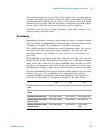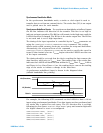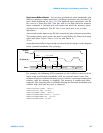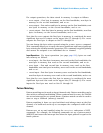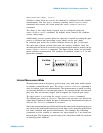
L4450A 64-Bit Digital I/O with Memory and Counter 8
L4400 User’s Guide 211
Set the number of times to output the trace. Each trace can be output once,
multiple times, or infinitely. The SOURce:DIGital:MEMory:NCYCles command
sets the number of times to output the trace. If not set to infinite, you can
output the trace from 1 to 255 times (the output is controlled by the
handshake).
Load the trace(s) into memory. Named traces are downloaded using the
TRACe:DATA:DIGital command. The channel width used should match the
width of the channel set in step 1. If you change the width of a bank,
all traces in memory are cleared. The trace names must start with a character
and may be up to 12 characters in length. The trace name used must be unique
to the bank. Up to 32 traces may be downloaded.
Traces can be added or deleted only when memory is disabled. Memory output
cannot be enabled unless the bank has a trace assigned to it.
For example, the following commands load two traces into memory for bank 1.
In this example, each byte of the LWORd to output is sent as a separate byte.
TRAC:DATA:DIG:LWOR (@1101), MyTrace1, 255, 200, 128, 0
TRAC:DATA:DIG:LWOR (@1101), MyTrace2, 254, 192, 64, 32
You can also send trace data in IEEE- 488 block format using this command.
The L4450A also has two special built- in traces for your use. You can generate
and download a count- up trace and a walking 1’s pattern using the
TRACe:DATA:DIGital:FUNCtion command. See the Programmer's Reference
Help file on the L4400 Product Reference CD- ROM for more details.
Set which trace to use. The SOURce:DIGital:MEMory:TRACe command
assigns the desired trace to the bank. This command allows you to switch
between the traces pre- loaded into the bank’s memory.
Enable the memory. Enable the memory on the bank using the
SOURce:DIGital:MEMory:ENABle command. This command sets the selected
trace to be the output and puts the bank in the wait-for-trigger state.
Trigger the output. When the default trigger source is used, the
SOURce:DIGital:MEMory:STARt command triggers the output. The selected
trace will be output when the handshake occurs.
If the trigger source has been set to one of the interrupt lines (see page
page 213), the output will wait for the interrupt to occur and then the
handshake to occur before the trace is output.
NOTE
You can generate a count-down or walking zero pattern by inverting the
data line polarity.



